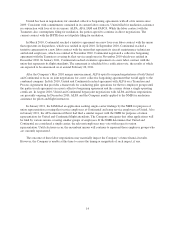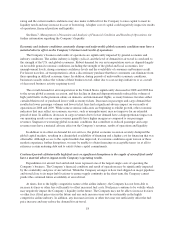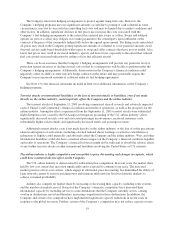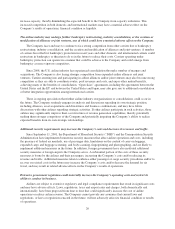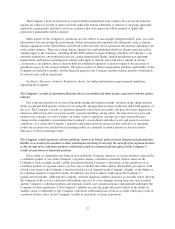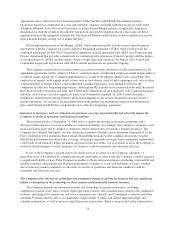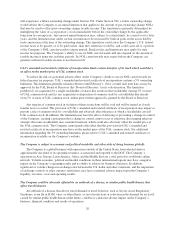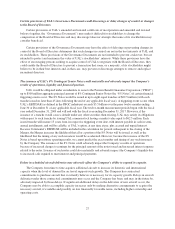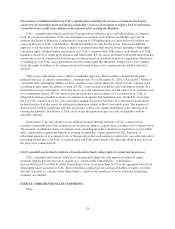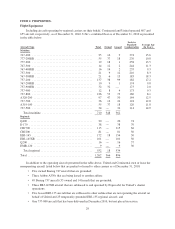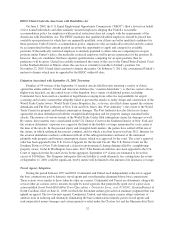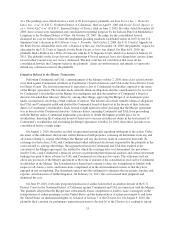United Airlines 2010 Annual Report Download - page 25
Download and view the complete annual report
Please find page 25 of the 2010 United Airlines annual report below. You can navigate through the pages in the report by either clicking on the pages listed below, or by using the keyword search tool below to find specific information within the annual report.UAL’s obligations for funding Continental’s defined benefit pension plans are affected by factors beyond
UAL’s control.
Continental has defined benefit pension plans covering substantially all of its U.S. employees, other than the
employees of its Chelsea Food Services division and Continental Micronesia, Inc. The timing and amount of
UAL’s funding requirements under Continental’s plans depend upon a number of factors, including labor
negotiations with the applicable employee groups and changes to pension plan benefits as well as factors outside
of UAL’s control, such as the number of applicable retiring employees, asset returns, interest rates and changes
in pension laws. Changes to these and other factors that can significantly increase UAL’s funding requirements,
such as its liquidity requirements, could have a material adverse effect on UAL’s financial condition.
The Company may never realize the full value of its intangible assets or our long-lived assets causing it to
record impairments that may negatively affect its results of operations.
In accordance with applicable accounting standards, the Company is required to test its indefinite-lived
intangible assets for impairment on an annual basis on October 1 of each year, or more frequently if conditions
indicate that an impairment may have occurred. In addition, the Company is required to test certain of its other
assets for impairment if conditions indicate that an impairment may have occurred.
During the years ended December 31, 2010, 2009 and 2008, the Company performed impairment tests of
certain intangible assets and certain long-lived assets (principally aircraft, related spare engines and spare parts).
The interim impairment tests were due to events and changes in circumstances that indicated an impairment
might have occurred. Certain of the factors deemed by management to have indicated that impairments may have
occurred include a significant decrease in actual and forecasted revenues, record high fuel prices, significant
losses, a weak U.S. economy, and changes in the planned use of assets. As a result of the impairment testing, the
Company recorded significant impairment charges as described in Note 4 to the financial statements included in
Item 8. The Company may be required to recognize additional impairments in the future due to, among other
factors, extreme fuel price volatility, tight credit markets, a decline in the fair value of certain tangible or
intangible assets, unfavorable trends in historical or forecasted results of operations and cash flows and the
uncertain economic environment, as well as other uncertainties. The Company can provide no assurance that a
material impairment charge of tangible or intangible assets will not occur in a future period. The value of our
aircraft could be impacted in future periods by changes in supply and demand for these aircraft. Such changes in
supply and demand for certain aircraft types could result from grounding of aircraft by the Company or other
carriers. An impairment charge could have a material adverse effect on the Company’s financial position and
results of operations.
Union disputes, employee strikes or slowdowns, and other labor-related disruptions, as well as the integration
of the United and Continental workforces in connection with the Merger, present the potential for a delay in
achieving expected merger synergies, increased labor costs or additional labor disputes that could adversely
affect the Company’s operations and impair its financial performance.
United and Continental are both highly unionized companies. As of December 31, 2010, UAL and its
subsidiaries had approximately 86,000 active employees, of whom approximately 72% were represented by
various U.S. labor organizations. The successful integration of United and Continental and achievement of the
anticipated benefits of the combination depend in part on integrating United and Continental employee groups
and maintaining productive employee relations. Failure to do so presents the potential for delays in achieving
expected merger synergies, increased labor costs and labor disputes that could adversely affect our operations.
In order to fully integrate the pre-merger represented employee groups, the Company must negotiate a joint
collective bargaining agreement covering each combined group. The process for integrating the labor groups of
United and Continental is governed by a combination of the RLA, the McCaskill-Bond Amendment, and where
applicable, the existing provisions of each company’s collective bargaining agreements and union policy.
Pending operational integration, the Company will apply the terms of the existing collective bargaining
23



